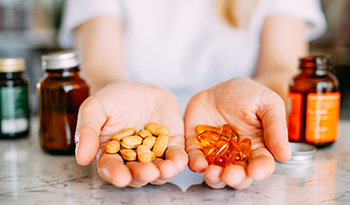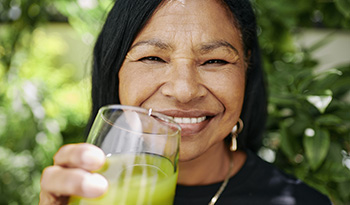천연 허브와 인지 건강

현행 치료 방법의 한계로 인한 허브 연구의 필요
치매는 기억력과 학습 능력, 그리고 의사 결정과 일상생활 활동에 점진적 손상을 일으키는 신경 퇴행성 질환입니다. 전 세계적으로 4억 7천 5백만 명의 사람들이 이러한 치매를 앓고 있으며 매년 7백 7십만 명의 사람들이 새로이 치매 진단을 받고 있습니다. 특히, 비만과 고혈압, 심장혈관 질환 및 뇌혈관 장애(예: ‘뇌졸중’)가 있는 분들은 혈관성 치매(Vascular dementia, VaD)에 걸릴 위험이 더욱 더 높습니다. 이러한 혈관성 치매(VaD)는 선진국의 경우, 전체 치매 중 10-15%를 차지하며 개발도상국에서는 전체 치매 사례의 30%를 차지할 정도로, 알츠하이머 질환(AD) 다음으로 흔한 형태의 치매입니다. 또한, 혈관성 치매 환자(VaD)의 40%는 알츠하이머(AD) 신경 퇴행성 병리학적 병변까지 보이고 있습니다. 혈관성 치매와 알츠하이머 잘환은 가장 흔한 유형의 혼합 치매입니다.
콜린에스테라제 억제제(Cholinesterase inhibitor)나 글루타메이트 수용체 길항제(Glutamate receptor antagonist) 같은 약물을 이용한 치료는 일부 알츠하이머 질환 환자에게는 상당한 효능을 보이지만, 혈관성 치매 환자에게는 그 효능이 그리 높지 않습니다. 따라서, 혈관성 치매 환자들은 약물치료 외에도 침술이나 영양 요법, 요가나 태극권 또는 음악 치료와 같은 보완 대체 요법(CAM)에 관심을 보이고 있습니다.
이에 따라 중국 전통 의학에서 사용되는 다양한 허브 약재들을 각각 또는 다양한 조합으로 연구하여 다양한 알츠하이머 질환과 혈관성 치매의 증상에 유용한 약효를 보이는 허브 약재가 있는지에 대한 연구가 이루어지고 있습니다. 이러한 연구가 활발하게 이루어지고 있는 허브 약재로는 은행(Ginkgo biloba)과 뱀톱 (Huperzia serrata), 강황(Curcuma longa), (Panax ginseng), 삼칠근(Panax notoginseng), 바코바(Bacopa monnieri), 단삼(Salvia miltiorrhiza), 사프란(Crocus sativus), 그리고 차(Camellia sinensis)가 있습니다. 다음은 건강한 성인과 치매 환자의 잠재적인 인지 기능 향상을 위해 연구가 이루어진 단일 허브 약재와 복합 허브 약제에 대한 간단한 소개입니다.
단일 허브의 약재의 장단점
최근 연구 결과에 따르면 은행(Ginkgo biloba) 추출물은 혈관성 치매 증상의 동물 실험에서 학습 능력과 기억력을 증진시키는 것으로 나타났다고 합니다. 엄격한 연구 기준을 충족하는 대규모 위약 대조 연구와 메타 분석에서도 은행(G. biloba) 추출물은 알츠하이머 질환과 혈관성 치매로 진단받은 환자의 인지 기능 감소 속도와 의사 결정, 그리고 행동 기능의 감소 속도를 늦추는 것으로 나타났습니다. 이는 은행(G. biloba)이 두뇌 기능을 증진시킴으로 기억력과 인지 기능을 개선시키고, 전 염증성 대식세포(Pro-inflammatory macrophages)의 활동 감소, 혈류 개선, 혈소판 활성화 인자의 활동 감소(로 인한 뇌졸중 위험 감소), 코르티코스테로이드(Corticosteroid production) 생산 감소, 포도당 흡수 증가, 신경 줄기세포의 증식, 뇌 손상 후 시냅스 소성(Synaptic plasticity) 촉진, 유리 콜레스테롤 순환 감소 및 두뇌의 &베타 아밀로이드(Beta;-amyloid) 전구 단백질 생산 감소를 유발시키는 메커니즘인 때문인 것으로 생각되고 있습니다.
Curcuma longa (강황)은 중국과 힌두, 그리고 아유르베다(Ayurvedic) 의학을 통해 수 세기에 걸쳐 췌장염과 관절염, 암과 염증, 그리고 신경 변성과 소화 장애를 비롯한 수많은 의료 질환에 사용되어 왔습니다. 동물 연구와 체외 연구 결과에 따르면, 강황의 약효성분인 커큐민(Curcumin)의 인지 기능 향상 효과는 지질 과산화(Lipid peroxidation)의 억제 및 반응성 산소종 (ROS)과 반응성 질소종(Reactive nitrogen species)의 제거, 그리고 NF-kB 활성화의 억제 및 항염증성 행위와 같은 다양한 메커니즘 때문이라고 합니다. 또한, 커큐민은 작은 베타- 아밀로이드종에 직접 결합하여 소섬유(Fibrillary)의 응집과 형성 작용을 저해할 수 있습니다. 경증 내지 중증도의 알츠하이머 질환 환자 36명을 대상으로 24 개월 간 실시된 무작위 임상 시험에서 커큐민(하루 2-4그램)을 투여한 환자와 위약을 투여한 환자를 비교하였을 때, 시험 참가자들의 인지 기능과 기억력에는 유의미하지 않은 변화가 나타났다고 합니다. 이러한 결과는 해당 연구에 사용된 강황 제제의 낮은 생체 이용률 때문으로 생각되고 있습니다.
이러한 동물 실험에서 밝혀진 결과에 따르면 (Panax ginseng)의 생체 활성 성분은 치매 환자의 인지 기능과 기억력을 증진시킬 수 있다고 합니다. 이러한 활성 성분인 진세노사이드(Ginsenoside) Rg5 아밀로이드-β 와 콜린에스터라제(Cholinesterase)의 활성을 억제한다고 합니다. 또한, 진세노사이드 Rg3는 유전자 발현을 통해 β-아밀로이드 펩티드의 분해를 촉진한다고 합니다. 또한, 인삼은 혈관 확장 기능을 통해 혈압을 낮추고 혈액 순환을 증진시킵니다. 2 건의 열린 12주 임상 시험 결과에서는 인삼이 알츠하이머 질환 환자의 인지 기능을 증진하는 것으로 나타났습니다. 또한, 최근에 실시된 2건의 열린 임상 시험에서 인삼을 하루에 4.5그램과 9그램 섭취한 알츠하이머 질환 환자는 인지 기능과 기억력이 향상되는 것으로 나타났습니다. 소규모로 실시된 2건의 위약 대조 임상 시험의 결과에 따르면 삼칠근(Panax notoginseng)은 두뇌의 혈류를 개선하여 혈관성 치매 환자의 기억력을 증진시킨다고 합니다.
바코바(Bacopa monnieri) (브라미)는 신경 보호제이면서 동시에 항산화제 효과를 발휘하여 자유 유리기(Free radical) 제거제로 작용하므로 두뇌의 혈류를 개선할 수 있습니다. 이 허브 약재는 기억력 증진제로 아유르베다 의학에서 널리 사용되고 있습니다. 건강한 성인과 알츠하이머 질환 환자의 인지 기능을 향상시키는 허브 약재에 대한 연구는 지금도 활발히 진행 중입니다.
사프란(Saffron, Crocus sativus) 은 중국 의학에서 항우울제와 항경련제, 그리고 카타르(Catarrh) 예방 치료제로 사용되어 오고 있습니다. 사프란 추출물에는 활성 성분인 크로친(Crocin)이 함유되어 있어 항산화 및 항 혈소판 특성을 나타내며, 치매의 동물 모델 시험에서 학습과 기억을 향상시키는 것으로 나타났습니다. 알츠하이머 질환 환자를 대상으로 22주 동안 시행된 이중 맹검 무작위 임상 시험에서 사프란을 하루에 30 mg 투약한 시험 참가자와 콜린에스테라아제 억제제(Cholinesterase inhibitor) 인 도네페질(Donepezil)을 하루 10mg 투여한 시험 참가자의 인지 기능이 향상되었습니다. 이 중 사프란을 투약한 환자의 경우, 도네페질 투여 환자보다 내약성이 더욱 우수했습니다. 또한, 알츠하이머 질환 환자를 대상으로 16주 동안 시행된 다른 이중 맹검 임상 시험에서 사프란을 투여한 환자는 위약을 투여한 환자에 비해 증세가 유의미하게 호전됨을 보이기도 했습니다.
차(Camellia sinensis)는 건강을 위해 널리 섭취되는 음료로서, 에피갈로카테킨-3-갈레트 (Epigallocatechin-3-gallate, EGCG)라는 활성 성분이 함유되어 있어, 항염증 작용을 비롯한 자유 유리기 제거 및 기타 작용을 통하여 신경을 보호해 줍니다. 일상생활에서 차를 자주 마시는 사람은 알츠하이머 질환으로 발전될 위험이 감소합니다. 두 건의 전향적 연구 결과에 따르면 노년에 녹차를 정기적으로 음용하는 습관이 인지 기능 손상 저하 및 치매의 위험 저하와 연관성을 보였다고 합니다.
단일 허브 약재를 이용한 치매 치료 효과에 대한 연구 결과에는 개별 임상 시험의 규모가 작고, 연구 기간도 짧으며, 방법론적 한계가 있다는 단점이 있습니다. 또한, 단일 허브 약재의 경우, 생체 활성 성분의 혈장 농도가 너무 낮아 효과를 발휘하기가 어렵다는 단점은, 복수의 생체 활성 성분을 통해 상승효과를 노리는 것이 유익할 것이라는 점을 시사합니다. 따라서, 중국 의학과 기타 동양 의학에서는 다양한 허브 약재를 조합하여 각각의 생체 활성 성분이 상승 효과를 통해 알츠하이머 질환이나 혈관성 치매와 같은 복잡한 병인의 질병에도 더욱 높은 효과를 발휘하도록 하고 있습니다. 최근에는 시스템 간 분석(System-to-system analysis)이라는 새로운 연구 기법을 이러한 허브 약제 간의 복잡한 상승효과에 적용하는 추세입니다.
복합 허브 약제의 전망
혈관성 치매 치료에 도움이 는 복합 허브 약제에 대해 이루어진 연구는 거의 없습니다. 일부 긍정적인 결과가 보고되어 있기는 지만, 연구 규모가 너무 작고 방법론적인 결함이 있어, 보고된 결과의 의미는 축소되고 있습니다. 2012년에 발표된 혈관성 치매에 대한 복합 허브 약제 연구에 대한 체계적 고찰에 따르면, 대부분의 복합 허브 약제는 기존의 약물이나 위약보다 유의미한 치료 효과를 보인다고 합니다. 허브 약체를 기존의 약물치료와 병용한 4건의 연구에서는 기존의 약물만을 단독으로 투여한 경우보다 인지 기능 향상 면에서 월등히 우수한 결과를 보였으나, 방법론적 결함으로 인해 이러한 결과의 의미가 크게 퇴색된 바 있습니다. 보다 최근에 실시된 메타 분석에는 (중국에서 시행되었던) 혈관성 치매 환자에 대한 24건의 무작위 임상 시험 결과도 검토하였습니다. 이 연구에서 시행된 하위 집단 분석 결과, 복합 허브 약제가 (10건의 연구에서) 피라세탐(Piracetam)보다 유의미한 인지 기능의 향상을 보였고, (3건의 연구에서) 위약보다 월등한 인지 기능의 향상을 보였습니다. 허브 약재를 이용한 치료를 받는 사람들은 피라세탐 치료를 받는 사람들에 비해 일상생활 활동이 크게 향상되는 것을 경험했습니다. 그러나 위의 다른 연구에서와 마찬가지로, 연구 결과의 중요성은 방법론적 결함으로 인해 그 의미가 축소되었습니다.
혈관성 치매에 좋은 복합 허브 개발을 위한 지속적인 노력
위와 같은 10년 이상의 연구에 부응하여 중국 의과학 아카데미(Academy of Chinese Medical Sciences)와 웨스턴 시드니 대학 (Western Sydney University)은 혈관성 치매 치료를 위한 표준화된 복합 허브 약제 개발을 위한 공동 연구를 계속하고 있습니다. 이에 따라 개발된 SLT라는 제형에는 은행(Ginkgo biloba), 인삼(Panax ginseng), and 사프란(Crocus sativus) 추출물의 표준화된 제제가 함유되어 있습니다.extracts.
이러한 생리 활성 성분의 최적 비율과 SLT의 최적 용량은 일련의 동물 연구를 통해 결정되었습니다. SLT의 전임상 시험은 치매 동물의 학습 능력과 기억력, 신경 병리학 지표 및 항산화제 에 있어 증상이 유의미하게 개선되는 결과를 보였습니다. 필자가 이 블로그를 작성하는 시점에서는 혈관성 치매 환자에 대한 효력을 입증하기 위한 대규모의 3단계(Phase III) 시험이 진행되고 있는 중입니다. 전임상 시험 단계부터 누적된 결과에 따르면 STL에는 국소 두뇌 허혈/재관류 손상, 혈소판 응집 감소 및 자유 유리기(Free radical) 제거 능력 증진 등 뇌혈관 계통에 다양한 효능을 발휘합니다.
SLT 치료나 위약 치료를 받는 사람들이 경험하는 부작용은 동일합니다. 소규모로 진행되는 1주간의 RCT에서는 무작위적 선택에 따라 SLT를 투약한 건강한 성인도 작업 기억력이 향상되는 결과를 보였습니다. 소규모로 이루어진 2단계(Phase II) 연구에서 무작위로 SLT를 투여받는 혈관성 치매 환자들은 인지 기능이 유의미하게 증진되었으며, 일부는 기억력과 청각 및 언어 처리와 관련된 뇌 영역에서 혈류 증가를 보여주었습니다. 혈관성 치매 가능성이 있는 325명의 환자를 대상으로 두 번째 실시한 12 개월간의 2단계(Phase II) 연구에서도 유사한 인지 기능 향상이 발견되었으나, SLT와 관련된 심각한 부작용은 보고되지 않았습니다. 필자가 이 블로그를 작성하는 시점에서는 여러 기관이 동시에 참여하는 3단계(Phase III) 임상 시험이 진행 중입니다. 3단계 시험을 통해 효과가 확인되고 있는 가운데, SLT는 효과적인 치료 방법이 뚜렷하지 않은 신경 퇴행성 질환인 혈관성 치매(VsD)를 치료할 수 있도록 효과가 입증된 새로운 치료제로 떠오르고 있습니다.
참고문헌
- Chang et al Herbal Medicine for theTreatment of Vascular Dementia: An Overview of Scientific Evidence 2016)
- Dementia Fact Sheet, World Health Organization, 2016.
- N. Kalaria, G. E. Maestre, R. Arizaga et al., “Alzheimer’s disease and vascular dementia in developing countries: prevalence, management, and risk factors,” The Lancet Neurology, vol. 7, no. 9, pp. 812–826, 2008.
- K. A. Nolan, M. M. Lino, A. W. Seligmann, and J. P. Blass, “Absence of vascular dementia in an autopsy series from a dementia clinic,” Journal of the American Geriatrics Society, vol. 46, no. 5, pp. 597–604, 1998.
- M. R. Farlow, M. L. Miller, and V. Pejovic, “Treatment options in Alzheimer’s disease: maximizing benefit, managing expectations,” Dementia and Geriatric Cognitive Disorders, vol. 25, no. 5, pp. 408–422, 2008.
- D. A. Levine and K. M. Langa, “Vascular cognitive impairment: disease mechanisms and therapeutic implications,”Neurotherapeutics, vol. 8, no. 3, pp. 361–373, 2011.
- H. Shim, “Vascular cognitive impairment and post-stroke cognitive deficits,” Current Neurology and Neuroscience Reports, vol. 14, no. 1, article 418, 2014.
- P. C. Chan, Q. Xia, and P. P. Fu, “Ginkgo biloba leave extract: biological, medicinal, and toxicological effects,” Journal of Environmental Science and Health. Part C, Environmental Carcinogenesis & Ecotoxicology Reviews, vol. 25, no. 3, pp. 211–244, 2007.
- J. Wang, W. Chen, and Y. Wang, “A ginkgo biloba extract promotes proliferation of endogenous neural stem cells in vascular dementia rats,” Neural Regeneration Research, vol. 8, no. 18, pp. 1655–1662, 2013.
- L.-Y. Zhang and Y.-L.Wang, “[Effects of EGb761 on hippocampal synaptic plasticity of vascular dementia rats],” Chinese journal of applied physiology, vol. 24, no. 1, pp. 36–40, 2008.
- Z.-X. Yao, Z. Han, K. Drieu, and V. Papadopoulos, “Ginkgo biloba extract (Egb 761) inhibits amyloid production by lowering free cholesterol levels,” Journal of Nutritional Biochemistry, vol. 15, no. 12, pp. 749–756, 2004.
- M. Hrehorovsk´a, J. Burda, I. Domor´akov´a, and E. Mech´ırov´a, “Effect of Tanakan on postischemic activity of protein synthesis machinery in the rat brain,” General Physiology and Biophysics, vol. 23, no. 4, pp. 457–465, 2004.
- P.-O. Koh, “Gingko biloba extract (EGb 761) prevents cerebral ischemia-induced p70S6 kinase and S6 phosphorylation,” American Journal of Chinese Medicine, vol. 38, no. 4, pp. 727–734, 2010.
- S. Saleem, H. Zhuang, S. Biswal, Y. Christen, and S. Dor´e, “Ginkgo biloba extract neuroprotective action is dependent on heme oxygenase 1 in ischemic reperfusion brain injury,” Stroke, vol. 39, no. 12, pp. 3389–3396, 2008.
- B. Spinnewyn, N. Blavet, and F. Clostre, “[Effects of ginkgo biloba extract on a cerebral ischemia model in gerbils],” Presse Medicale, vol. 15, no. 31, pp. 1511–1515, 1986.
- M.-N. Rocher, D. Carr´e, B. Spinnewyn et al., “Long-term treatment with standardized Ginkgo biloba Extract (EGb 761) attenuates cognitive deficits and hippocampal neuron loss in a gerbil model of vascular dementia,” Fitoterapia, vol. 82,no. 7, pp. 1075–1080, 2011.
- W.-Z. Li,W.-Y.Wu, H. Huang, Y.-Y.Wu, and Y.-Y. Yin, “Protective effect of bilobalide on learning and memory impairment in rats with vascular dementia,” Molecular Medicine Reports, vol. 8, no. 3, pp. 935–941, 2013.
- L. S. Schneider, “Ginkgo biloba extract and preventing Alzheimer disease,” JAMA, vol. 300, no. 19, pp.2306–2308,2008.
- R. Ihl, M. Tribanek, N. Bachinskaya, and Gotaday Study Group, “Efficacy and tolerability of a once daily formulation of Ginkgo biloba extract EGb 761(R) in Alzheimer’s disease and vascular dementia: results from a randomised controlled trial,” Pharmacopsychiatry, vol. 45, no. 2, pp. 41–46, 2012.
- S. Gauthier and S. Schlaefke, “Efficacy and tolerability of Ginkgo biloba extract EGb 761_ in dementia: a systematic review and meta-analysis of randomized placebo-controlled trials,” Clinical Interventions in Aging, vol. 9, pp. 2065–2077, 2014.
- M.-S. Tan, J.-T. Yu, C.-C. Tan et al., “Efficacy and adverse effects of Ginkgo Biloba for cognitive impairment and dementia: a systematic review and meta-analysis,” Journal of Alzheimer’s Disease, vol. 43, no. 2, pp. 589–603, 2015.
- Y. Wang, L.-Q. Huang, X.-C. Tang, and H.-Y. Zhang, “Retrospect and prospect of active principles from Chinese herbs in the treatment of dementia,” Acta Pharmacologica Sinica, vol. 31, no. 6, pp. 649–664, 2010.
- J. M. Ringman, S. A. Frautschy, G. M. Cole, D. L. Masterman, and J. L. Cummings, “A potential role of the curry spice curcumin in Alzheimer’s disease,” Current Alzheimer Research, vol. 2, no. 2, pp. 131–136, 2005.
- F. Yang, G. P. Lim, A. N. Begum et al., “Curcumin inhibits formation of amyloid oligomers and fibrils, binds plaques, and reduces amyloid in vivo,” The Journal of Biological Chemistry, vol. 280, no. 7, pp. 5892–5901, 2005.
- J. M. Ringman, S. A. Frautschy, E. Teng et al., “Oral curcumin for Alzheimer’s disease: tolerability and efficacy in a
- 24-week randomized, double blind, placebo-controlled study,” Alzheimer’s Research andTherapy, vol. 4, no. 5, article 43, 2012.
- S. Chu, J. Gu, L. Feng et al., “Ginsenoside Rg5 improves cognitive dysfunction and beta-amyloid deposition in STZ induced memory impaired rats via attenuating neuroinflammatory responses,” International Immunopharmacology, vol. 19,no. 2, pp. 317–326, 2014.
- H. Yang, J. Zhang, R. M. Breyer, and C. Chen, “Altered hippocampal long-term synaptic plasticity in mice deficient in the PGE2 EP2 receptor,” Journal of Neurochemistry, vol. 108, no. 1, pp. 295–304, 2009.
- J.-X. Liu, W.-H. Cong, L. Xu, and J.-N. Wang, “Effect of combination of extracts of ginseng and ginkgo biloba on acetylcholine in amyloid beta-protein-treated rats determined by an improved HPLC,” Acta Pharmacologica Sinica, vol. 25, no.9, pp. 1118–1123, 2004.
- J. Shi, S. Zhang, M. Tang et al., “The 1239G/C polymorphism in exon 5 of BACE1 gene may be associated with sporadic Alzheimer’s disease in Chinese Hans,” American Journal of Medical Genetics Part B: Neuropsychiatric Genetics, vol. 124, no. 1, pp. 54–57, 2004.
- Y. Sun, J. Ke, N. Ma, Z. Chen, C. Wang, and X. Cui, “[Effects of root rot on saponin content in Panax notoginseng],” Zhong yao cai = Zhongyaocai = Journal of Chinese medicinal materials, vol. 27, no. 2, pp. 79–80, 2004.
- K.-T. Choi, “Botanical characteristics, pharmacological effects and medicinal components of Korean Panax ginseng CA Meyer,” Acta Pharmacologica Sinica, vol. 29, no. 9, pp. 1109–1118, 2008.
- J.-H. Heo, S.-T. Lee, K. Chu et al., “An open-label trial of Korean red ginseng as an adjuvant treatment for cognitive impairment in patients with Alzheimer’s disease,” European Journal of Neurology, vol. 15, no. 8, pp. 865–868, 2008.
- S.-T. Lee, K. Chu, J.-Y. Sim, J.-H. Heo, and M. Kim, “Panax ginseng enhances cognitive performance in Alzheimer disease,” Alzheimer Disease and Associated Disorders, vol. 22, no. 3, pp. 222–226, 2008.
- J.-H. Heo, S.-T. Lee, M. J. Oh et al., “Improvement of cognitive deficit in Alzheimer’s disease patients by long term treatment with Korean red ginseng,” Journal of Ginseng Research, vol. 35, no. 4, pp. 457–461, 2011.
- J. Tian, “Ginseng may improve memory in stroke dementia patients,” in Proceedings of the American Stroke Association Meeting, Augusta, Canada, 2003.
- Q. F.Gui,Y.M.Yang, S. H. Ying, andM. M. Zhang, “Xueshuantong improves cerebral blood perfusion in elderly patients with lacunar infarction,” Neural Regeneration Research, vol. 8, no. 9, pp. 792–801, 2013.
- A. Russo and F. Borrelli, “Bacopamonniera, a reputed nootropic plant: an overview,” Phytomedicine, vol. 12, no. 4, pp. 305–317, 2005.
- S. K. Bhattacharya, A. Bhattacharya, A. Kumar, and S. Ghosal, “Antioxidant activity of Bacopa monniera in rat frontal cortex, striatum and hippocampus,” Phytotherapy Research, vol. 14, no. 3, pp. 174–179, 2000.
- A. Russo, A. A. Izzo, F. Borrelli, M. Renis, and A. Vanella, “Free radical scavenging capacity and protective effect of Bacopa monniera L. on DNA damage,” Phytotherapy Research, vol. 17, no. 8, pp. 870–875, 2003.
- N. Kamkaew, C. N. Scholfield, K. Ingkaninan, N. Taepavarapruk, and K. Chootip, “Bacopa monnieri increases cerebral blood flow in rat independent of blood pressure,” Phytotherapy Research, vol. 27, no. 1, pp. 135–138, 2013.
- C. Stough, A. Scholey, V. Cropley et al., “Examining the cognitive effects of a special extract of Bacopa monniera (CDRI08: Keenmind): a review of ten years of research at Swinburne University,” Journal of Pharmacy and Pharmaceutical Sciences, vol. 16, no. 2, pp. 254–258, 2013.
- C. K. Stough, M. P. Pase, V. Cropley et al., “A randomized controlled trial investigating the effect of Pycnogenol and Bacopa CDRI08 herbal medicines on cognitive, cardiovascular, and biochemical functioning in cognitively healthy elderly people: theAustralian ResearchCouncil Longevity Intervention (ARCLI) study protocol (ANZCTR12611000487910),” Nutrition Journal, vol. 11, article 11, 2012.
- K. Abe and H. Saito, “Effects of saffron extract and its constituent crocin on learning behaviour and long-term potentiation,” Phytotherapy Research, vol. 14, no. 3, pp. 149–152, 2000. H. Hosseinzadeh and T. Ziaei, “Effects of Crocus sativus stigma extract and its constituents, crocin and safranal, on intact memory and scopolamine−induced learning deficits in rats performing the Morris water maze task,” Journal of Medicinal Plants, vol. 5, no. 19, pp. 40–50, 2006.
- H. Hosseinzadeh and H. R. Sadeghnia, “Safranal, a constituent of Crocus sativus (saffron), attenuated cerebral ischemia induced oxidative damage in rat hippocampus,” Journal of Pharmacy and Pharmaceutical Sciences, vol. 8, no. 3, pp.394–399, 2005.
- S. W. Jessie and T. P. Krishnakantha, “Inhibition of human platelet aggregation and membrane lipid peroxidation by food spice, saffron,”Molecular and Cellular Biochemistry, vol. 278, no. 1, pp. 59–63, 2005.
- S. Akhondzadeh, M. S. Sabet, M. H. Harirchian et al., “A 22-week, multicenter, randomized, double-blind controlled trial of Crocus sativus in the treatment of mild-to-moderate Alzheimer’s disease,” Psychopharmacology, vol. 207, no.4, pp.637–643, 2010.
- S. Akhondzadeh, M. S. Sabet, M. H. Harirchian et al., “Saffron in the treatment of patients with mild to moderate Alzheimer’s disease: a 16-week, randomized and placebo-controlled trial,” Journal of Clinical Pharmacy andTherapeutics, vol. 35, no. 5, pp. 581–588, 2010.
- S. A. Mandel, T. Amit, L. Kalfon, L. Reznichenko, and M. B. H. Youdim, “Targeting multiple neurodegenerative diseases etiologies with multimodal-acting green tea catechins,” Journal of Nutrition, vol. 138, no. 8, pp. 1578S–1583S, 2008.
- A. B. Sharangi, “Medicinal and therapeutic potentialities of tea (Camellia sinensis L.)—a review,” Food Research International, vol. 42, no. 5-6, pp. 529–535, 2009.
- M. Noguchi-Shinohara, S. Yuki, C. Dohmoto et al., “Consumption of green tea, but not black tea or coffee, is associated with reduced risk of cognitive decline,” PLoS ONE, vol. 9, no. 5, Article ID e96013, 2014.
- H. Wagner and G. Ulrich-Merzenich, “Synergy research: approaching a new generation of phytopharmaceuticals,” Phytomedicine, vol. 16, no. 2-3, pp. 97–110, 2009.
- X. Zhou, S. W. Seto, D. Chang et al., “Synergistic effects of Chinese herbal medicine: a comprehensive review of methodology and current research,” Frontiers in Pharmacology, vol. 7, article 201, 2016.
- K. Iwasaki, S. Kobayashi, Y. Chimura et al., “A randomized, double-blind, placebo-controlled clinical trial of the Chinese herbal medicine ‘Ba Wei Di Huang Wan’ in the treatment of dementia,” Journal of the American Geriatrics Society, vol. 52, no. 9, pp. 1518–1521, 2004.
- K. Nagata, E. Yokoyama, T. Yamazaki et al., “Effects of yokukansan on behavioral and psychological symptoms of vascular dementia: an open-label trial,” Phytomedicine, vol. 19, no. 6, pp. 524–528, 2012.
- S. C. Man, K. W. Chan, J. Lu, S. S. Durairajan, L. Liu, and M. Li, “Systematic review on the efficacy and safety of herbal medicines for vascular dementia,” Evidence-Based Complementary and Alternative Medicine, vol. 2012, Article ID 426215, 22 pages, 2012.
- D. Gong, J. Xu, and Y. Fan, “Meta-analysis of clinical trials of oral Chinese herbal prescriptions for treatment of vascular dementia based on mini mental state examination scores,” European Journal of Integrative Medicine, vol. 7, no. 2, pp. 108–117, 2015.
- L. Xu, W. Cong, C. Wei, and J. Liu, “Effects of Weinaokang (SLT) on dysmnesia in micemodels,” Pharmacology and Clinics of Chinese Materia Medica, no. 6, pp. 60–62, 2007.
- L. Xu, J.-X. Liu, W.-H. Cong, and C.-E. Wei, “[Effects of Weinaokang capsule on intracephalic cholinergic system and capability of scavenging free radicas in chronic cerebral hypoperfusion rats],” Zhongguo Zhongyao Zazhi, vol. 33, no.5, pp. 531–534, 2008.
- W. H. Cong, J. X. Liu, and L. Xu, “Effects of extracts of Ginseng and Ginkgo biloba on hippocampal acetylcholine and monoamines in PDAP-pV717I transgenic mice,” Zhongguo Zhong xi yi jie he za zhi Zhongguo Zhongxiyi jiehe zazhi, vol. 27, no. 9, pp. 810–813, 2007.
- W.-H. Cong, B. Yang, L. Xu et al., “Herbal extracts combination (WNK) prevents decline in spatial learning and memory in APP/PS1 mice through improvement of hippocampal A plaque formation, histopathology, and ultrastructure,” Evidence-based Complementary and Alternative Medicine, vol. 2012, Article ID478190, 9 pages, 2012.
- S. Seto, A. Jenkins, H. Kiat, A. Bensoussan, J. Liu, and D. Chang, “Protective effects of a standardised herbal formulation,
- Sailotong, on hydrogen peroxide (H2O2) induced damage in EA.HY926 Cells,” The Journal of Alternative and Complementary Medicine, vol. 22, no. 6, p. A35, 2016.
- T. Li, H.-M. Liu, Y. Lu et al., “Aphase I tolerance and safety study of Sailuotong capsule,” Chinese Journal of NewDrugs, vol. 21,no. 1, pp. 62–67, 2012.
- G. Z. Steiner, A. Yeung, J.-X. Liu et al., “The effect of Sailuotong (SLT) on neurocognitive and cardiovascular function in healthy adults: a randomised, double-blind, placebo controlled crossover pilot trial,” BMC Complementary and
- Alternative Medicine, vol. 16, no. 15, 2016. J. Liu, D. Chang, D. Chan, J. Liu, and A. Bensoussan, “A randomised placebo-controlled clinical trial of a Chinese herbal medicine for the treatment of vascular dementia,” in Proceedings of the 2nd International Congress for Complementary Medicine Research, Munich, Germany, 2007.
- D. Chang, B. Colagiuri, and R. Luo, Chinese Medicine used to Treat Dementia, Advances in Natural Medicines, Nutraceuticals and Neurocognition, CRC Press, 2013.
면책사항:웰니스 허브의 취지는 의학적인 진단이나 치료를 제공하는 것이 아닙니다.














































































 목차
목차















